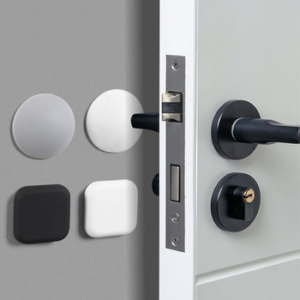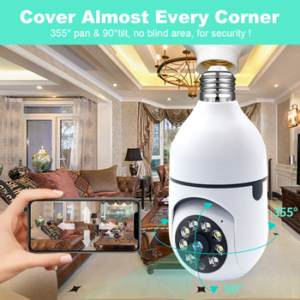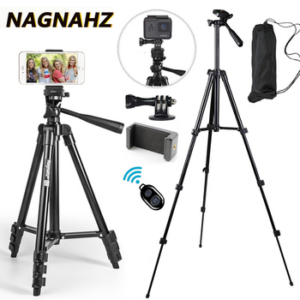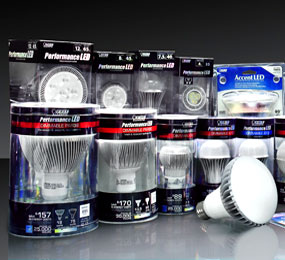
The technological advances in the development of LED light bulbs have been fast and furious, with manufacturers competing to design LED bulbs suitable for every application in the home, while working to lower the retail price to a tipping point of mass consumer acceptance.
Today, these goals have largely been met. LED light bulbs are more cost-effective than their incandescent or CFL counterparts, and specialty LEDs have become widely available for the different lighting applications in modern homes.
Here are a few tips to help you make sense of the many energy-efficient lighting solutions on the market today, and how to choose the best LED bulb for your lighting needs.
1. The new Lumens rating makes buying LED bulbs much simpler
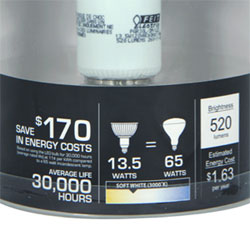 Choosing a light bulb today is more complicated than ever, and the choice of bulbs keeps growing. Consumers have to choose between incandescents, CFLs, halogens and LEDs, and a multitude of sizes and shapes, different bases, and of course widely differing prices.
Choosing a light bulb today is more complicated than ever, and the choice of bulbs keeps growing. Consumers have to choose between incandescents, CFLs, halogens and LEDs, and a multitude of sizes and shapes, different bases, and of course widely differing prices.
The FTC has recently mandated that, by 2012, all light bulb packages will be standardized with new labels which will make it much easier to buy light bulbs, whether they be incandescent, LED, CFL or halogen. The main indicator on the light bulb package will be “lumens”, which will replace the current “watts”. Lumens represents the amount of light emitted by a light source, and is a more accurate measure of the brightness of a bulb.
| Incandescent Watts | CFL Watts | LED Watts | Lumens (Brightness) |
|
40 |
8 – 12 13 – 18 18 – 22 23 – 30 30 – 55 |
4 – 5 6 – 8 9 – 13 16 – 20 25 – 28 |
450 890 1210 1750 2780 |
So no matter what kind of bulb you are interested in, simply comparing lumens will enable you to compare the brightness level each bulb will deliver. After you determine the lumen level you prefer, you can then look to other indicators such as energy efficiency, lifetime run cost, and dimmability to select the ideal bulb for your application.
To learn more about the upcoming new labelling system for all light bulbs, see our article: Lumens are the New Watts.
2. LED bulbs contain no mercury
One of the hurdles to broad consumer acceptance of energy-efficient CFL bulbs is the presence of a small amount of mercury in the bulbs. Consumers are concerned that they may be adding mercury to the environment when the bulb is disposed. If a CFL bulb is broken, consumers are advised to treat the broken bulb as a hazardous material.
The mercury issue with CFLs is confusing because manufacturers reason that actually less mercury enters the environment when CFLs are used to replace incandescent bulbs. A power plant will emit 10mg of mercury to produce the electricity to run an incandescent bulb compared to only 2.4mg of mercury to run a CFL for the same time. The net benefit of using the more energy efficient lamp is positive, and this is especially true if the mercury in the fluorescent lamp is kept out of the waste stream when the lamp expires. However, this reasoning only applies if your electricity comes from coal-fired sources.
The presence of mercury in CFL bulbs is a real issue with consumers. At Eartheasy’s online store, we have discontinued selling CFLs because of customer concern over the presence of mercury in CFL bulbs.
LED bulbs contain no mercury, so there is no special concern with handling or disposal of LED bulbs.
3. LEDs give instant light, and many LED bulbs are dimmable
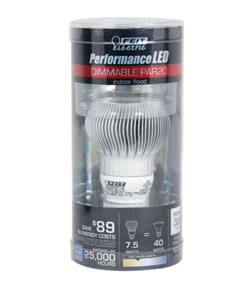 When turning on CFLs and tubular fluorescent light bulbs, there is a slight hesitation before brightness is achieved, and some bulbs may flicker during warm up or even during operation. Unlike fluorescents, LED bulbs, like incandescent bulbs, reach full illumination as soon as they are turned on. This is a real advantage over CFL bulbs in areas of the home where lights are frequently turned on and off. Also, LED lights produce a steady light which does not flicker.
When turning on CFLs and tubular fluorescent light bulbs, there is a slight hesitation before brightness is achieved, and some bulbs may flicker during warm up or even during operation. Unlike fluorescents, LED bulbs, like incandescent bulbs, reach full illumination as soon as they are turned on. This is a real advantage over CFL bulbs in areas of the home where lights are frequently turned on and off. Also, LED lights produce a steady light which does not flicker.
Earlier versions of LED bulbs had the disadvantage of not being dimmable. Today, many LED bulbs are designed to work in dimmable switches which are provided in many lamps and home lighting fixtures. Just be sure to check the package to ensure the bulb you have selected is dimmable.
LED lights last a long time and unlike other light bulbs, they do not burn out, but rather dim over time.
4. LEDs won’t contribute to heat buildup in your home
This summer has been the hottest on record, and homeowners are increasingly interested in measures which can help reduce the amount of heat generated within the home. Electric lighting is one of the main culprits. Incandescent lights produce ideal illumination in terms of brightness and quality of light, but they also produce a considerable amount of heat.
A 100 watt incandescent bulb produces 100 watts of power. From an energy point of view, it puts out 100 Joules of energy per second. In a small closed room, 4 m (12ft) x 4 m(12ft) x 3 m(9ft) or 48 m³ with a single 100w bulb:
48 m³ x 1.2 kg/m³ = 58 kg of air
100J = 1000 J/kgC x ∆T x 58 kg
∆T = 0.0017 deg C, change in temp. per second
In one hour, the bulb would produce a 6 degree C rise. or 11 deg F. This assumes the room is closed to ventilation, so the temperature would be lower if the room were ventilated, or larger. But it serves to illustrate that the heat contribution from an incandescent bulb is significant.
LED bulbs, by contrast, remain cool. High power LEDs are designed with heat sinks, usually aluminum struts around the lower bulb, which keeps operating temperatures low. LED bulbs do not contribute to heat buildup in a room.
5. Insects are not attracted to UV-free LED bulbs
Many LED bulbs (but not all) do not give off ultraviolet light, which is known to attract flying insects. Check the package label for UV information if you are interested in this feature.
There are also specialty LED bulbs which have yellow lenses or bulbs, which are designed for outdoor use in carports, decks or on patios. These yellow bulbs will not attract the bugs and moths which seem to cluster around ordinary white bulbs. These bulbs produce adequate light for the intended area; they just don’t attract bugs.
6. Choose LED bulbs which are UL Listed, not UL Compliant
A light bulb package marked “UL Compliant” is no assurance that the LED bulb has been tested or approved by the Underwriters Laboratory. It only means that the manufacturer has followed recommended UL guidelines in production and technical aspects. A “UL Listed” LED bulb has passed stringent tests put forth by UL, and consumers are advised to look for the UL Listed mark.
In the race to garner a share of the emerging LED market, manufacturers may use the UL Compliant mark to help sell more light bulbs, but this is no guarantee of bulb quality. Consumers should be wary of new LED bulbs which are priced very low, are sourced from unknown suppliers, or have unrealistic product claims.
7. Don’t let the sticker price shock you
The initial cost of LED bulbs may be misleading to consumers unfamiliar with the new LED bulbs. While the initial cost of the LED bulb is higher than the cost of an incandescent or CFL bulb, the savings is recouped over time because the bulb will last longer and use less energy than other bulbs. You will see the savings in your electric bill.
For a cost comparison chart which shows how you will save money by buying LED bulbs, see our page LED vs CFL vs incandescent bulbs.
The trend in lighting is moving towards more widespread adoption of LEDs for residential as well as commercial use. Today, builders of new homes are installing LED bulbs in many fixtures, and as LED bulb prices continue to go down, this trend is going to grow. A little knowledge about these bulbs will help you get the best value for your dollar.
Source from eartheasy.com






